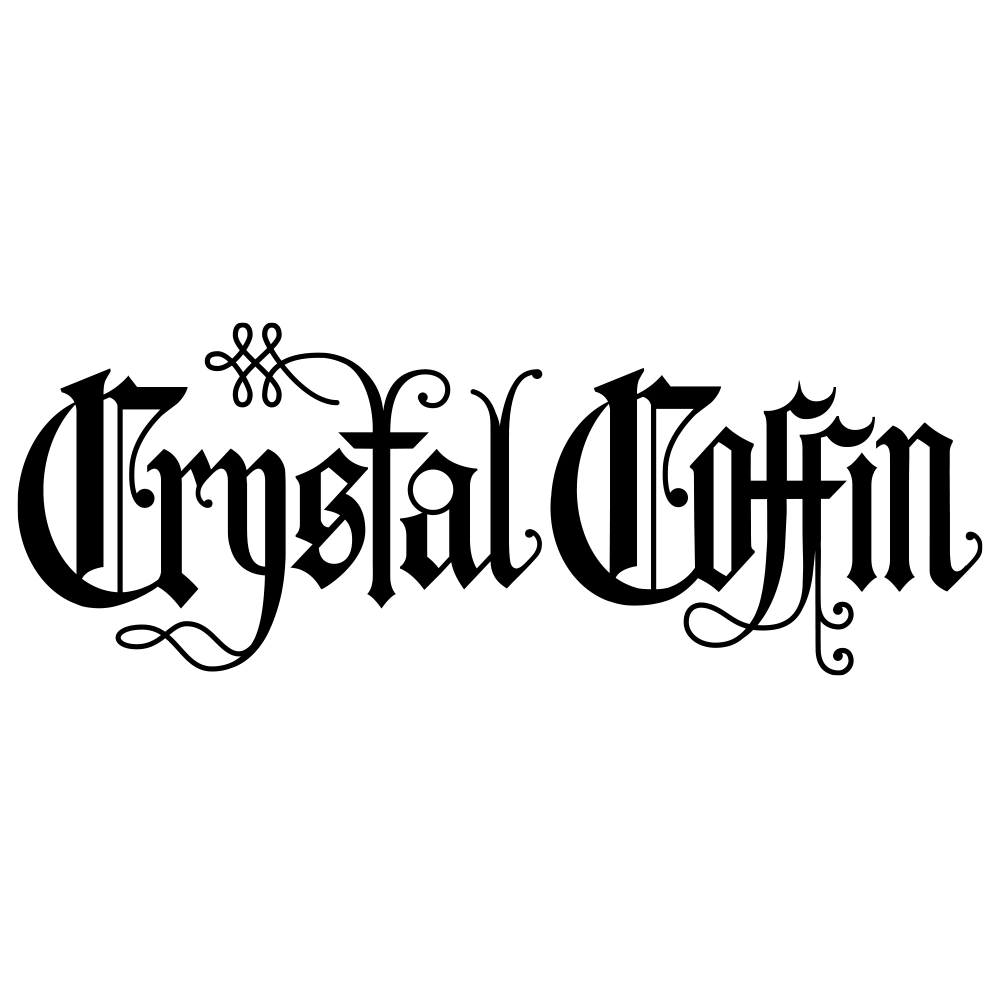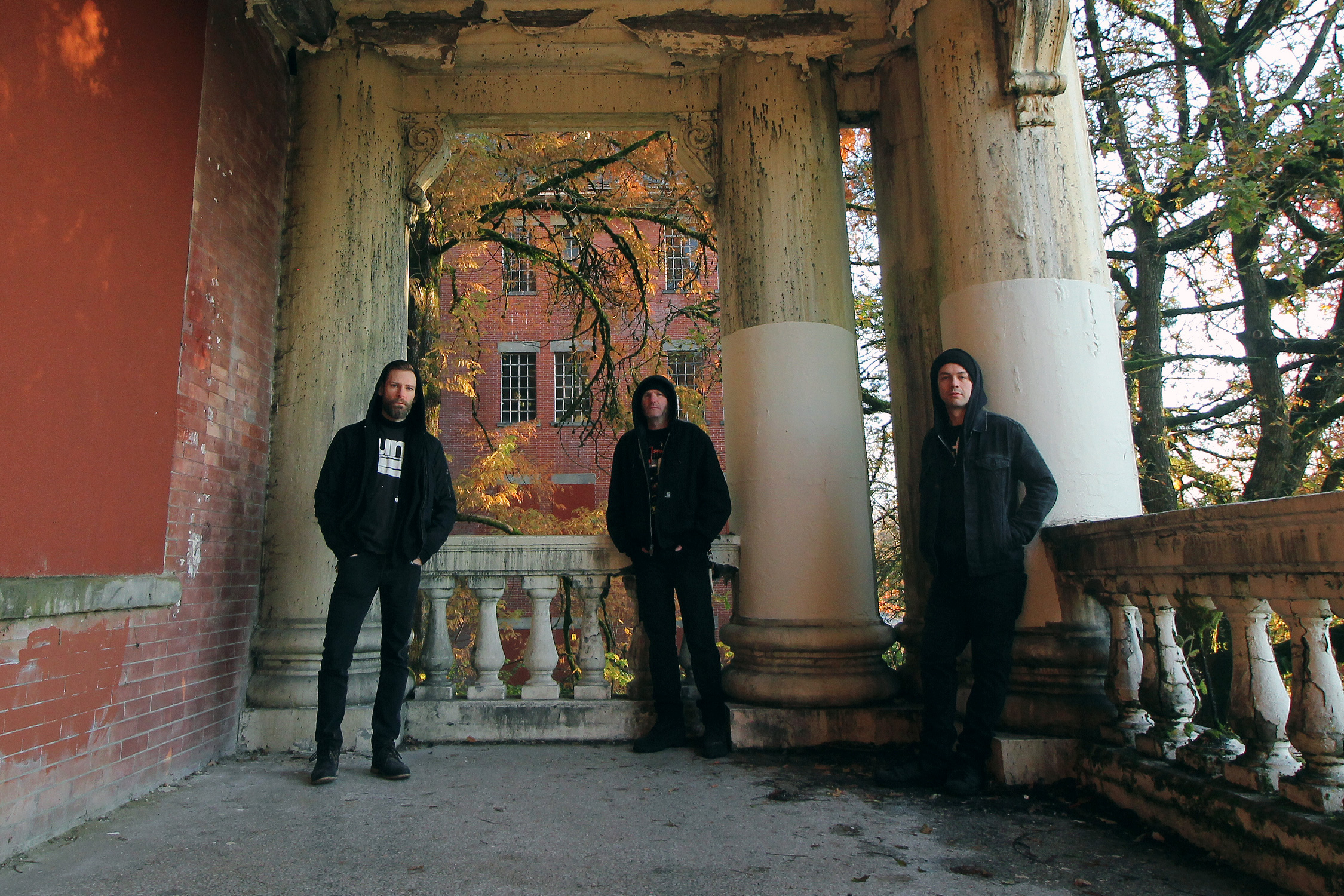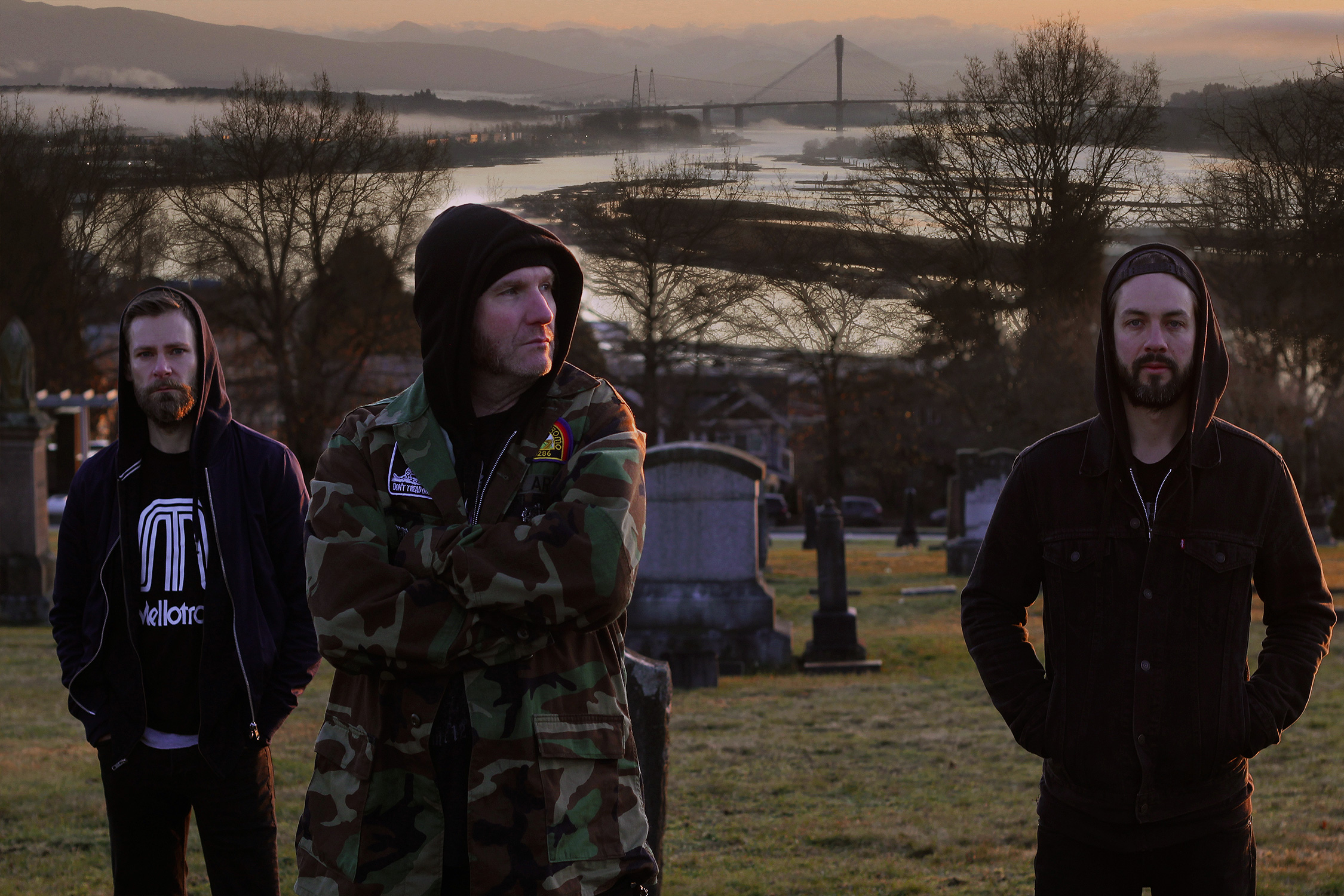
ABOUT
CRYSTAL COFFIN is a melodic black metal trio from Vancouver, Canada that was formed in 2016 by Lenkyn Ostapovich (guitars, synths, piano, balalaika, secondary vocals + visuals), Aron Shute (vocals, bass guitar), and Rob Poirier (drums). Comprised of members from previous Vancouver acts DESTROY ALL and CASKETS, as well as current doom outfit KOMA, their music references a shared interest in 1970’s/80’s Italian horror cinema, both sonically and visually. CRYSTAL COFFIN combines black metal song styles with influences of prog and ambient/electronic music while re-imagining 19th and 20th century atrocities as poetry and melody.
Combining a love for vintage horror, folk, history, storytelling and other esoteric influences, CRYSTAL COFFIN released their first full-length album, The Transformation Room, on March 6th 2020 to favourable reviews. The album presents imagery of the Holodomor famine that tore families and villages apart in Soviet-era Ukraine during the early 1930s and contains lyrics that are washed in pathos set over music both brutal and beautiful.
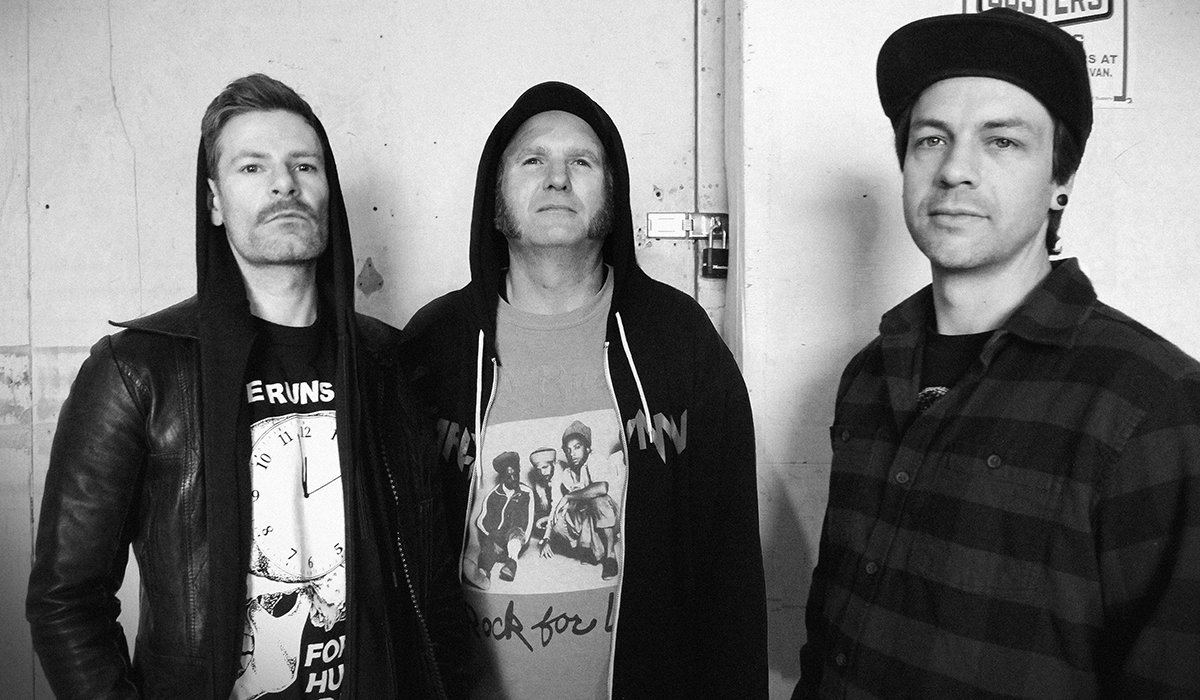
(L to R: Lenkyn Ostapovich; Aron Shute; Rob Poirier)
Only a few weeks after the release of their debut album, CRYSTAL COFFIN was forced to sideline plans for live shows in support of The Transformation Room due to the global effects of Covid-19. Almost over night, plans to build momentum and fan following were shunted as social distancing measures yielded a great amount of isolation and intensity. With the new landscape becoming the new normal, the band decided to pivot and quickly dove into writing new material in an individualist approach. Between May and August 2020, CRYSTAL COFFIN completed the 8 new songs that would come to form their second release, The Starway Eternal.
Released on October 15, 2021, The Starway Eternal is a sci-fi concept album that utilizes the Chernobyl nuclear disaster in Pripyat, Ukraine as a backdrop for lyrical content. Set during the days leading up to the catastrophic events at the nuclear power plant in April 1986, the album loosely tells the story of an operator’s discovery of a cosmic gateway behind one of the reactor’s secondary consoles. Allowing for exploration outside the known cosmos, the operator goes on a search for gods and angels - a search for omniscience or an omnipotent being helping to steer the actions on earth. During one such trip, the meltdown at Chernobyl’s reactor 4 occurs closing the portal-way to earth. Her navigation back must now be through the layers of fiery atmosphere.
The band's third full-length was released on October 31st, 2023. Entitled The Curse of Immortality, the album looks forward to a future where the limitations on existence are no more, for better or for worse. Less a formal concept album from its predecessor, the eight tracks loosely depict a protagonist whose failed attempts at suicide have placed him into a rehabilitation center wherein clandestine medical personnel experiment on the captured and unconscious patients at night in chambers below. Through a combination of cryogenetics, evil rites, and state control, the subject involuntarily becomes the first successful completed case for verified immortality - a life that will no longer require death. The music and the lyrics found throughout are darker, heavier, and faster than anything Crystal Coffin have released and stand as the sonic culmination of the band's efforts and intentions over the past six years.
RELEASES
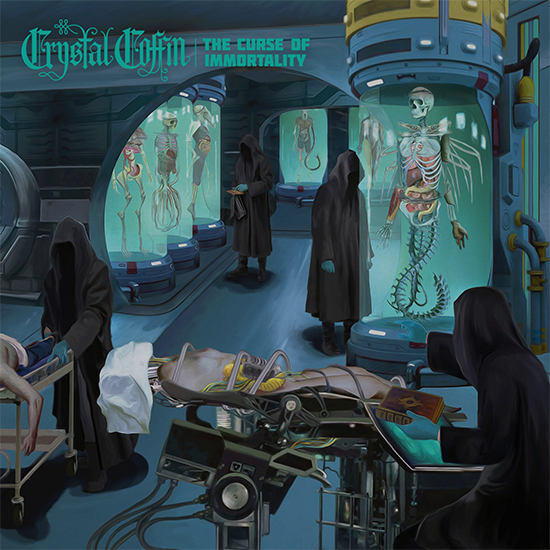
THE CURSE OF IMMORTALITY
2023
A1 - Shadows Never Cast
A2 - The Undead
A3 - The Vortex of Earth and Death
A4 - Final Breaths (vocals by Aron + Lenkyn)
B1 - Cryogenesis
B2 - Rise
B3 - Leviathans Encased
B4 - The Closing of the Crystal Coffin
Recorded Feb-Mar 2023 at Raincity Recorders. Engineered and mixed by Jesse Gander w/ Szymon Wojciech. Mastered by Stu McKillop, Railtown Mastering. Released independently on October 31, 2023 by A Beast in the Field. All rights reserved.
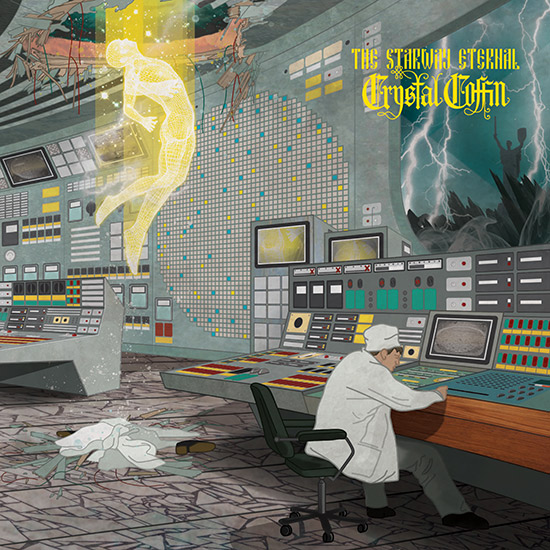
THE STARWAY ETERNAL
2021
A1 - Shapeshifter Huntsman
A2 - The Starway Eternal
A3 - Skeletons
A4 - Console of Horror
B1 - The Red Forest (vocals by Lenkyn + Aron)
B2 - Cremation: Between Fire and Ice
B3 - The Descent
B4 - Mega Tomb, including Tomorrow's Ghost
Recorded April 2021 at Raincity Recorders. Engineered and mixed by Jesse Gander. Mastered by Stu McKillop, Railtown Mastering. Released independently on October 15, 2021 by A Beast in the Field. All rights reserved.
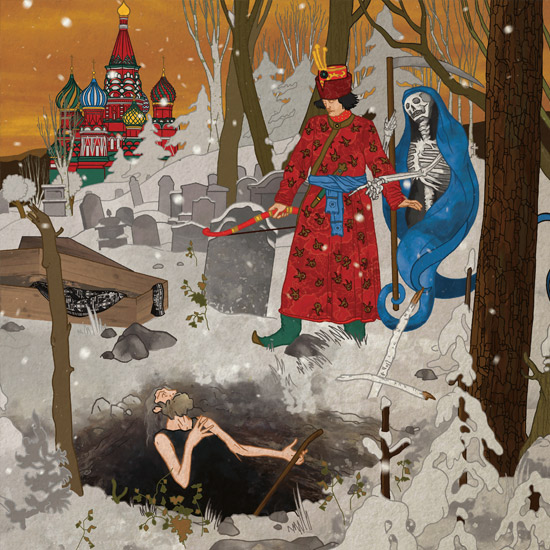
THE TRANSFORMATION ROOM
2020
A1 - Prelude: My Friendly Epistle
A2 - Ride Through the Night
A3 - Famine (The Waking of the Beast)
A4 - As Certain as the Grave
B1 - The Inverted Burial of Taras
B2 - I Emerge
B3 - As We Pass
B4 - The Transformation Room
Recorded November 2019 at Raincity Recorders. Engineered and mixed by Jesse Gander. Mastered by Stu McKillop, Railtown Mastering. Released independently on March 6, 2020 by A Beast in the Field. All rights reserved.

DEMO
2019
A1 - Ride Through the Night
A2 - As We Pass
A3 - Incantation of the Winter Cannibal
A4 - Famine (The Waking of the Beast)
A5 - I Emerge
Recorded January 2019 at Grindcity Recording. Engineered and mixed by Kevin Grindon. All rights reserved.
INTERVIEWS
The following interviews were conducted with Crystal Coffin's guitarist/keyboardist/artist, Lenkyn Ostapovich, during the release process of the band's second album, The Starway Eternal, Autumn 2021.
(The music, the artwork, and the lyrics of Vancouver-based Crystal Coffin are fascinating in and of themselves, but reveal themselves to be even more fascinating and alluring with the additional info furnished by this excellent interview of the band conducted by Comrade Aleks.)
Oh modern black metal scene! A cabinet of curiosities! You can find everything here from old school die-hard true and evil devils to Cascadian naturalists, from true / untrue occult visionaries and charlatans to bands who are hard to categorize. And as many bands say, they don’t care about categories and genre definitions, it’s for labels, for listeners and for us “journalists”.
Crystal Coffin is another blackened riddle one could notice due to the premiere last month of their second album at NCS. This Vancouver-based trio performs (crazy or intellectual – choose for yourself) progressive and melodic black metal with truly authentic stories behind their albums.
Crystal Coffin is carried on the shoulders of Rob Poirier (drums), Aron Shute (vocals, bass), and Lenkyn Ostapovich (guitars, keyboards) who we spoke with about the band's recent release in October 2021.
******
Well, first of all, taking into account the artworks of both The Transformation Room and The Starway Eternal, and a few other things including one interview I’ve found, it seems some of the band’s members have Russian roots. How many comrades are in Crystal Coffin? How did you manage to gather the band actually?
Crystal Coffin began in 2017 after two Vancouver bands, Destroy All and Caskets, both came to an end. The three of us that comprise Crystal Coffin (Aron Shute – vocals, bass; Lenkyn Ostapovich – guitars, synths, piano, balalaika, supporting vocals; and Rob Poirier – drums) share a love for Wetton-era King Crimson, second wave Black Metal, bands like Gong, Amon Düül II, and Magma, and the haunting synth work of Fabio Frizzi/Italian horror cinema, and so we wanted to see what could come from this new relationship. The group began practicing and writing out of extended jams and over the next 2.5 years would write music that would end up on a 5-song demo, and then later fully form our debut release, The Transformation Room, in March 2020.
Okay, each album starts with an artwork, and the artwork for The Transformation Room presents us two recognizable Russian symbols – Moscow’s Kremlin and fable-story personage Ivan Tzarevich, but at the same time the album’s concept is (partly) based around the Holodomor tragedy. How do these symbols fit The Transformation Room idea?
Lenkyn provides all the visuals for the band – from their album artwork to their social media presence and materials shared online – and so it’s been rather easy for us to iterate on various visual ideas and tie them into the lyrical content we’re trying to present. We hope that our body of visual work unifies as nicely as the musical parts we record. As for the first album’s cover, Lenkyn has long been a fan of Ivan Bilibin‘s illustrative works and felt that we could reference and repurpose some of the images to support the out-of-time, quasi-science-fiction world that we began trying to create with The Transformation Room. The characters depicted help support a story arch of struggle, discipline, oppression, and transformation while creating a folk-like aesthetic that has resonated with a lot of people.
Crystal Coffin’s music is built on a black metal fundament and decorated with elements of prog and… and other types of metal. How would you sum up your influences in Crystal Coffin? How do you see this combination of genres from the inside?
We’ve all been fans of prog rock at various stages of our lives as well as numerous metal genres, soundtrack scoring, folk, and pop styles. We love the body of work Enslaved has built upon since the ’90s and more recently have watched how Wolves In The Throne Room have managed to infuse their epics with a huge amount of pathos derived from many different musical genres. When we include a layer or two of synths we’re typically doing so to help create an atmosphere rather than a new melody and, so far, the sounds we’re using are helping to define what Crystal Coffin sounds like. We’re really excited to see what evolves leading into our next recording!
How did you determine a point of the sound’s balance for Crystal Coffin? It’s easy to slip off in total chaos mixing genres, but the ideas you put into The Transformation Room are quite clear and coherent.
I think a whole lot of credit goes to Jesse Gander at Raincity Recorders here in Vancouver, Canada, who engineered and mixed everything we recorded! He has an incredibly warm production style and is into melody and musicianship alongside his penchant for punk and aggressive playing. We all work well together because he’s able to quickly hear the melodies we’re burying in the layers of guitars or backing synths and pull them out independently so everything is sitting appropriately in the mix. A lot of the comments we receive have to do with the clarity of our sound and how accessible our brand of black metal is for listeners who might not have originally been into some of the more raw production values of classic albums. To put it another way, he really gets what we’re going for!
There’s balalaika in your arsenal. How easy was it to insert it in the album’s canvas? Did you feel a seduction to use more exotic (for metal) instruments in Crystal Coffin?
During the writing of The Starway Eternal, Lenkyn refurbished an old balalaika from Chernihiv, Ukraine (not that easy of a project to do in Vancouver…finding parts, etc) and, once completed, it had a really nice and subtle folk sound that supported the thematic content we were generating. It was nice to include just a bit of the instrument on the album and not try to pull it through every single track. It will probably turn up again on future Crystal Coffin recordings too!
Jesse, our mixing engineer, was able to find a sweet spot in the mix of ‘Console Of Horror’ where it could just faintly be heard alongside the blasting drums and guitars while keeping its acoustic qualities fairly realistic. With Lenkyn’s heritage and lifelong interest in eastern European cultures, it’s not a huge leap to want to include such an instrument in the band, but if we were to start incorporating sitars or tablah drums that would probably come across rather insincere!
What was the reaction to The Transformation Room? The album is great, it’s pretty original and for sure it shows Crystal Coffin’s individuality. But I wonder if artwork was a barrier for some listeners.
The Transformation Room took a fairly long time to prepare, as we were still figuring out what types of songs would work best in our band. From our first many jams as a new group, we were oftentimes writing in a very plodding Doom style – songs like ‘Famine (The Waking of the Beast)’ and ‘I Emerge’ are stylistically quite Doom-based, but by the time we were ready to head into the studio to record, song styles like ‘The Transformation Room’ and ‘Ride Through the Night’ were coming together rather easily. We began to identify that that style of songwriting allowed for just the right amount of melody to come through while still remaining associated to traditional black and thrash sounds.
Also because of all these features (sound, concept, artworks) Crystal Coffin stands aside from other bands… Do you feel yourself a part of the Canadian black metal scene or something?
Our band has only come to prominence during the last two years and that slight rise has been restrained by the effects of the global pandemic. We have not been able to showcase our music live much at all and cannot yet identify with being part of any musical movement within Canada. There are numerous incredible bands in Canada, in all genres, and we know that many of them have not simply stayed afloat during this difficult time but have also been able to continually create their art and are only now beginning to share it with others! It should be a very interesting and rewarding time for fans over the next while!
What’s your doom metal influences? Do you prefer its sludgy side like stuff you do with Koma?
Aron and Rob have a natural connection when it comes to the doomier, sludgier parts of Crystal Coffin as they’ve played for years together in Koma and have a shared love of bands like Neurosis and Yob. There’s a fair amount of our writing that comes out of heavy jams in that style with Aron presenting a circular, repeating riff, Rob setting a proper intensity with the drums and some appropriate shifts in playing here and there, and Lenkyn adding a bit more melody or sparkle on top of things.
A song off of our first album, ‘As Certain As the Grave’, is a good example of this relationship: the entire extended coda to that piece started as a descending bass line that was heavy and somewhat hypnotic. After the break in that song, we steadily added layer upon layer until the mix felt like it was about to overflow. The effects in those final moments as the lasting notes of the guitar solo hang are some of the best to come from this band yet. There are a lot of really awesome Doom bands in this area of the country – Balkan comes to mind – so we’ll always be bolstered by some really solid influences!
The Starway Eternal resembles that simplistic style of The Transformation Room. Did you aim to keep it this primitive way? It’s not a problem to get expressive, with detailed and professional artwork today, so I bet that I’m right… And do I get right that a monument we see in the window of the laboratory is the Motherland statue in Kiev, Ukraine?
We created the sort of album cover(s) that we enjoy ourselves and felt would represent the music and themes therein. There are symbols included in both of the album jackets that can speak to various stories and statements the songs make while still allowing for the listener to puzzle together their own valuable interpretations.
Is it important for you to make people understand what your songs are about? Do you need a communicative element between the band and its followers?
The fact that people have found themselves so invested in the subject matter of both The Transformation Room and The Starway Eternal has been a really positive byproduct of those two releases. We’re fans of lyrics that have some poetry and substance to them and that conjure memorable scenes in the listener’s imagination while possessing a cadence that supports the song’s energy and intention. We’re not at all trying to gain support for any of our apparent viewpoints of philosophies but rather use a disjointed form of storytelling to unify our tracks across the 35-45 minutes that we have the listener’s attention.
The process of creating these tracks is maybe a bit unique: we have a loose idea of an overarching theme/story that we might want to try and capture before much of the writing gets underway. Over time, Lenkyn creates numerous pages of prose that Aron then repurposes and expands upon to suit the cadence and delivery he’s after within each track. It’s a fairly William Burroughs-esque approach of tearing apart the sum into pieces and reformulating the equation into something new, but with the same thrust. Aron’s presentation allows for multiple interpretations while still supporting the visuals we create fitting within the larger album as a whole. Because of this “dismantling” and “rebuilding,” concerns for track order rest moreso upon the energy arch track-to-track than on the particular lyrics in each song.
Regarding the communicative element between the band and its fans, the entire process of creating art becomes more rewarding when it is received by and resonates with fans across the community/country/world, so it would be nearsighted to think that that doesn’t have a positive effect on the three of us! Art in all of its forms allows the participant to take from it what they may. If the work we’re releasing helps bring a listener to topics, themes, or visuals that they may not have encountered elsewhere, then we believe that’s an entirely positive result.
Why did you decide to dedicate the new album to the Chernobyl catastrophe? Sky’s series Chernobyl (2019) is still popular, and there’s a Russian (pretty shitty) movie based on the same events, its actual topic again. Was it the reason why you turned your eyes to it?
The realities of the Chernobyl catastrophe only acted as a jumping-off point for writing a science fiction story that could act as the spine for the lyrics. We ourselves are fans of fiction and art that reference historical occurrence and repurpose images and figures to create a new telling of events, or present notions of nihilism, mortality, and struggle while seeking to resonate with moments of beauty, sadness, and fantasy. For many decades, the Ukrainian people have had to press onward past collective tragedy and/or times of oppression and so we have included cues that indicate our belief that, ultimately, a resounding good can manifest out of the earthly struggle we all must endure from time-to-time. We want to acknowledge the inspiration and awe that can come from moments in our shared humanity.
Both of your albums were released DIY, though I see that you’re now in touch with a PR-agency in order to promote the album. Do you see now that it’s a better way to deal with promotion and distribution?
Yes, sure.
As I understand you have no intention to stop and are already working on new material. Can you share some details about the next Crystal Coffin release?
We’re always writing new material but it takes many weeks or months to know if it’ll remain fun to play, compelling for a listener, and within the style we want to showcase in that moment for the band. Currently, we’re working on a live set that incorporates tracks from both albums, but we’re also hoping to release a 3-track EP sometime in 2022 that will include the better songs we’re jamming on these days. The new pieces, so far, are somehow both more aggressive and black than what we’ve released while also being snappier and “more to the point”.
Thanks for the interview; let’s hope it’ll help to spread Crystal Coffin’s message a bit further. Do you have some few final words for our readers? Did we miss something?
We just want to take any opportunity we can to thank people for listening! The response has been overwhelmingly positive and we’re so appreciative of the feedback we’ve received. We know things haven’t been easy around the world since our band has been a part of the fray, so the fact that our albums have found the attention of those around the globe during that time means a great deal to us. We just wish everyone health and happiness, and hope to see them in 2022!
1.For those that have never heard of you before, can you tell us a little bit about the band?
Crystal Coffin began in 2017 after two Vancouver bands, Destroy All and Caskets, ended. The three of us that comprise Crystal Coffin, Aron Shute, Lenkyn Ostapovich, and Rob Poirier, share a love for Wetton-era King Crimson, second wave Black Metal, and the haunting synth work of Fabio Frizzi/Italian horror cinema and wanted to see what could come from this new combination. The group began practicing and writing out of extended jams and over the next 2.5 years would write music that would end up on a 5-song demo and then later fully form our debut release, The Transformation Room, in March 2020. The debut album's content puzzled together some of the eastern European atrocities that led into the Second World War while creating its own mythology whereby a level of earthly suffering readies its players for the realm of the infinite. In late Spring 2020, with the global pandemic taking full grip soon after the release of the our first album, much of the follow-up was written during multiple lockdowns in western Canada and used the content from the first album, both musically and lyrically, as a jumping off point for inspiration. The Starway Eternal again paints a picture of suffering but this time one rooted in science fiction with the historical elements of the Reactor 4 meltdown of Chernobyl in 1986 acting as a backdrop. Through the black-inspired playing and doom-laden riffs, we always try to maintain an element of melody, intensity, and approachability in our brand of playing.
2.In October you have a new album coming out, musically how does it differ from your previous full length and demo?
The Starway Eternal shows a band gaining confidence. There is a heightened sense of confidence in the vocal delivery, in the dense layers of songwriting, and in the focus of the storytelling. By the time we had completed recording our first album, we had a pretty good sense of which tracks were working more naturally within a developing style versus others that maybe didn't feel so much like ourselves. The songwriting for the second album happened a lot quicker and, because of that, there is probably a better sense of compatibility between the tracks. The music itself is more traditionally black and uptempo from beginning to end with only a few spots here and there for doom breaks or interludes. We've also added many more layers of synth but have tried to keep their placements logical rather than to overwhelm the listen with them. We feel that it's a much more intense listen than the first album for sure.
3.The lyrics on the new album cover the historical realities of the Chernobyl power plant meltdown of 1986, can you tell us a little bit more about your interest in this topic?
I think that as a group we've always appreciated ambitious albums from artists that try to tell a story with their music and lyrics and so we've continually tried to pick something in world history from over the past 100-150 years to tether the themes that we explore. With the first album, it was the forced famine (Holodomor) during the 1930s in the Soviet Union that allowed us to combine images, descriptions, and words about a finite period in time to create a poetry that deals with our own individual mortality and placement within a supposed infinite. A lyric such as "...awake in grave, remember life, I am alone and dark where once was light." can resonate with nearly everyone as it's imbued with a darkness, sadness, weight, and regret that we all feel from time-to-time and conjures an image of a body beyond the physical realm sitting moments after that burial still uncertain of what to do with their [now infinite] existence. Regarding the lyrics on The Starway Eternal, we purposefully wanted to write a more aggressive and unforgiving album from beginning to end. Given our respective ages, we actually all lived through the tragic news of the power plant meltdown in Spring 1986 and had the horrific and confusing images burned into our minds from the TV screens. To me, there is a symbolism that can be pulled from such a catastrophe and applied to individuals: there is a fine line that comes with our ambitions that can work in our favor or ruin us, be it based in addiction, obsession, personal health, finances, war, or disaster, and sometimes the greatest of intentions end up opposite to where your ideals were pushing you to initially. We have a lineage to the people in Eastern Europe/Ukraine and given their decades of political and human struggles they're an example of having an undying spirit in times of unjustified despair. So we pushed these ideas and formed a story that we as fans of science fiction and horror genres would enjoy ourselves and created a central character who, while working at the power plant in Pripyat, Ukraine discovers a portalway into the hidden cosmos. With such an opportunity she begins a search for gods and/or angels - metaphysical beings that might help provide a sense of meaning to our world here below the mythological heavens - beyond time and space. During one such moment in space though, the portalway back to earth is closed during Reactor 4's meltdown and so the only path back to earth is to fall through the hellfire atmosphere. We've taken various historical elements - the nuclear program in Soviet Russia, the story of Vladimir Komarov who tragically burned during re-entry in 1967, the first female cosmonaut Valentina Tereshkova, the meltdown on April 26th, 1986 - and have posited that through a consistent earthly struggle a higher form of meaning can be ascertained.
4.The band has also mentioned an interest in history, science fiction and horror, what influence does this have on the musical style that you play?
Those influences come through via the layers of synths typically which help provide an atmosphere. We've had some references to Hawkwind and so that's a perfect example of something we're striving for: a space sound that is heavy, disorienting, declarative and beautiful! During parts of the song, Console of Horror, there is a balalaika that be heard, so that points to the region and histories that we're leveraging in the aforementioned themes and a lot of the tones used during the synth parts are taken from Fabbio Frizzi or Goblin pieces since those bodies of work have had such a lingering impact on us, both sonically and visually!
5.What is the meaning and inspiration behind the name 'Crystal Coffin'?
We actually started this band with the name 'Butchers' for a while. It was only later during the preparation for recording The Transformation Room that we changed our name. A lyric in our first single from that album, As We Pass, contains "for years I've used crystal coffins to send shepherds away...". Within the context of that song, it's an idea that there remains a visibility within death, but as far as becoming a band name we just thought it had a visual appeal to it along with an alliterative quality that felt like something timeless and curious.
6.Can you tell us a little bit more about the artwork that is presented on the new album cover?
The visual nature of this band is important for all of us and so we want to continually build a family of materials that work together in a larger sense while still representing an immediate need for each piece in its moment. I provide all of the illustrative and visual/layout work for Crystal Coffin and so it's relatively easy for us three to chat together and come up with a shortlist of ideas to iterate upon and execute. If you're familiar with our first LP's cover, it's easy to see the shared style of The Starway Eternal's cover. Previously, subjects were being sent down into the earth but now we now have a subject rising into the cosmos; it's a similar idea of "escape" from our world. This passageway is moreso a symbol than an actual reality being committed then and there in the room, but thankfully such lofty visuals have a tendency to lend themselves to such spacey themes.
7.On a worldwide level how has the reaction been to your music by fans of black metal?
We've been thrilled with the international reach of our first release and with pre-orders/pre-saves for The Starway Eternal so far! I suppose you never know where your music will resonate and so it's been hugely rewarding to have fans develop across Europe, South America, and throughout the US and Canada. The amount of LPs we've had to ship overseas to places in Germany, Denmark, and The Netherlands has been great! We believe that the music represented in the second release is stronger than on the first so hopefully that support will continue to spread.
8.What is going on with 'Koma' these days, which also shares a couple of the same band members?
Koma is currently on hiatus as one of the keys in that group, Kevin Grindon, had to temporarily relocate. They have a really impressive following due to their intense live shows over the years so hopefully once all the guys find themselves together in the same city a similar creative energy can continue!
9.Where do you see the band heading into musically during the future?
Our first two albums treaded upon some pretty lofty images and themes and tried, for better or for worse, to execute those ideas into a seamless thematic tracklisting. These days, when we get together to rehearse and write we are trying to write the best songs we can with less concern for anything beyond that. I expect that over the next 12 months Crystal Coffin will continue to release new music with a few back-to-back EPs. Musically, we will continue to pull the melody out of the aggressive, straightforward black metal stylings and continue to experiment with multiple vocals and layered synths. Also, it's long been a goal to incorporate further percussive elements into our music and soundscapes.
10.What are some of the bands or musical styles that have had an influence on your music and also what are you listening to nowadays?
The three of us share a love for King Crimson's numerous iterations, for the aggressive prog/space sounds of Hawkwind, Jean-Luc Ponty, Gong, Magma, and Amon Duul II, and memorable horror soundtracks from the 1970s and 80s. This summer we've enjoyed 'Cascades' by Vancouver brethren Ulvik which is an incredible and emotive listen from beginning to end and recently have had the latest from Wolves In The Throne Room and Full Of Hell on repeat.
11.Before we wrap up this interview, do you have any final words or thoughts?
We just want to thank everyone, both near and far, who has supported us during such a rough year and a half and hope for everyone's health and safety from here on!

Awake in grave, remember life.
I am alone and dark where once was light.



